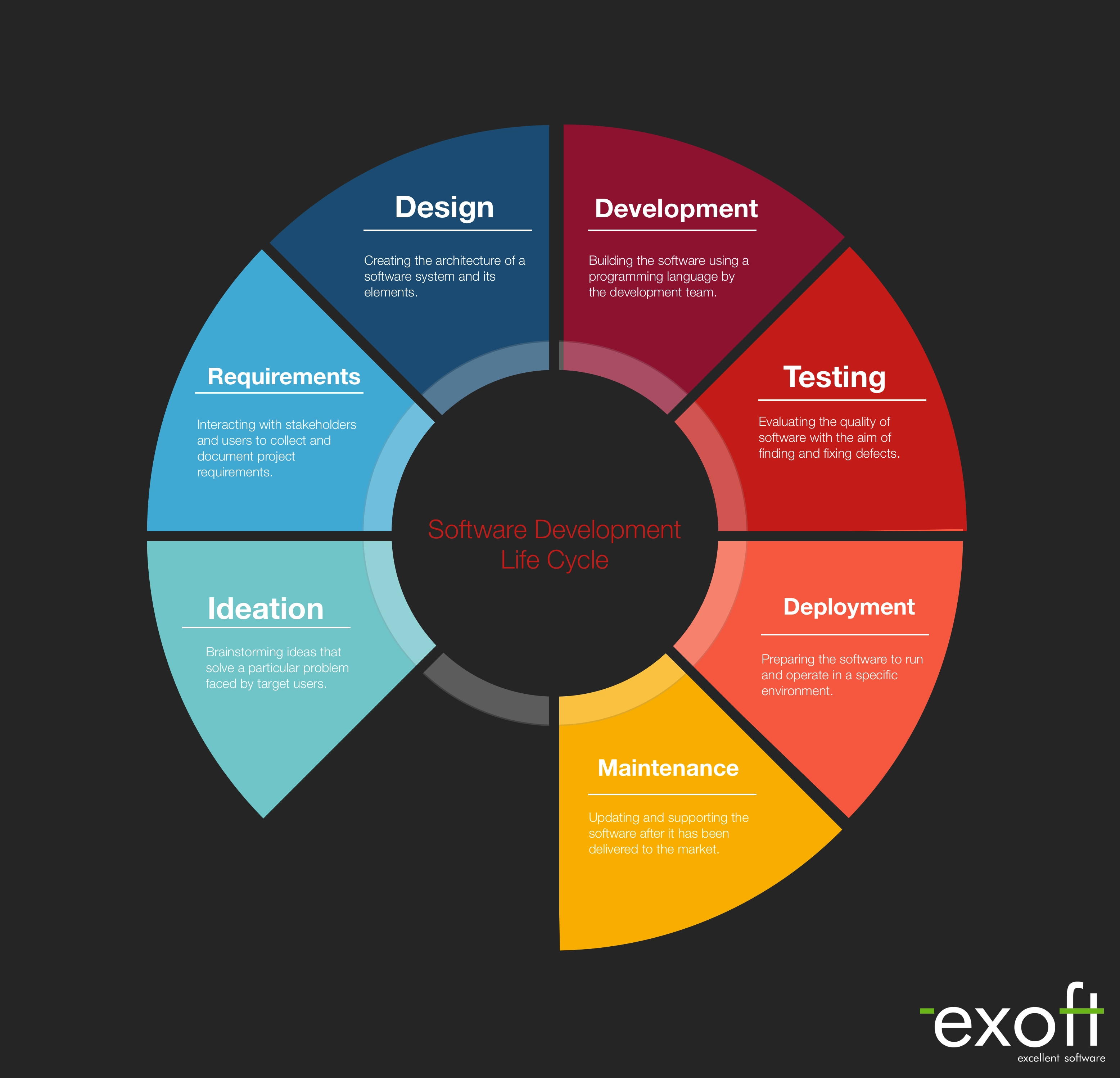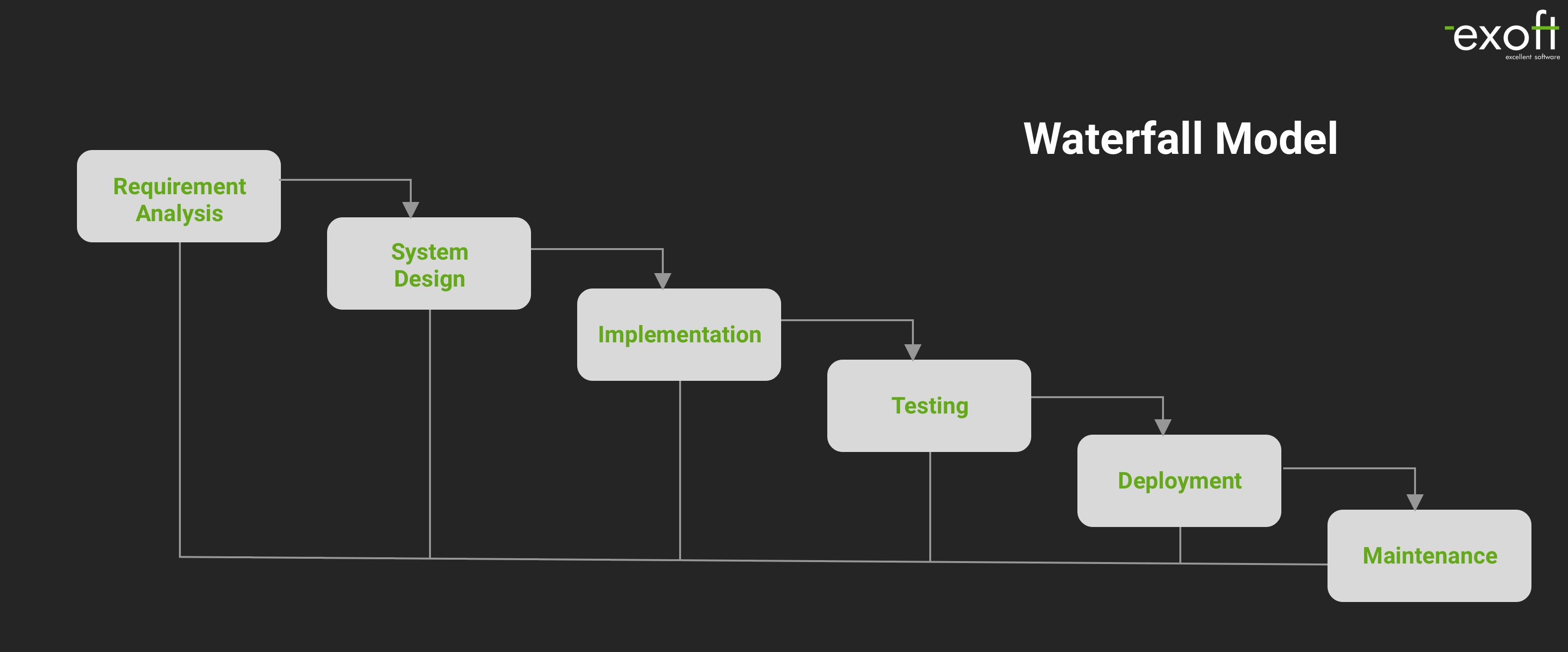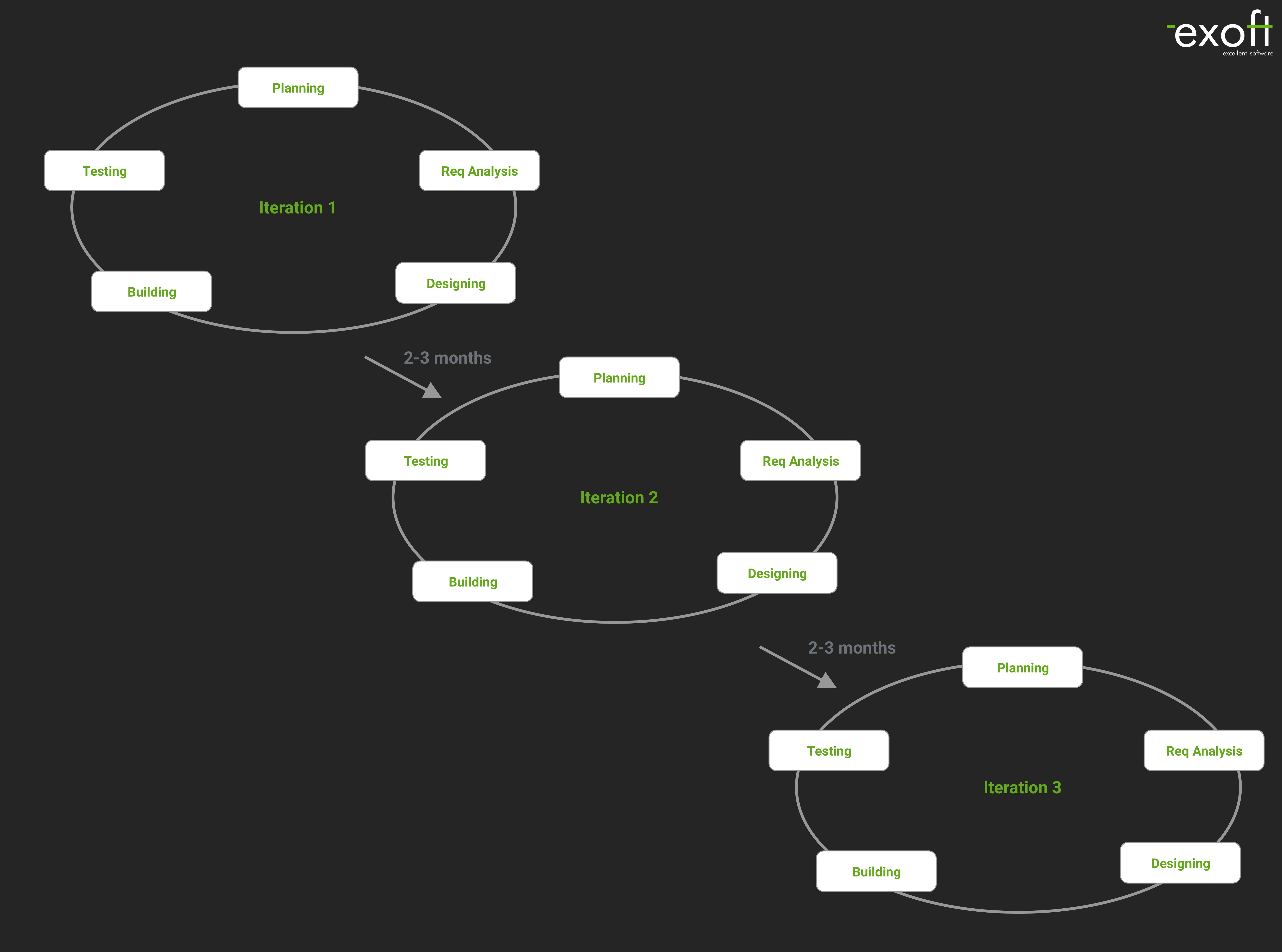Case study
Learn how the System Development Life Cycle (SDLC) provides a structured approach to software projects. Our post breaks down its structured phases, including planning, analysis, design, implementation, testing, and maintenance. We explain how well-structured SDLC prevents disorganized workflows, unmet quality standards, and stakeholder misalignment.
Starting a custom software development project may
become an incredibly challenging task for multiple C-level managers. The numerous technical
details and uncertainties are often a barrier to achieving desired goals in the end.
Fortunately, you can overcome this particular barrier. The only thing to know is how a system development life cycle (SDLC) methodology must perform correctly and what you should expect from all its stages.
This article will define what is a system development life cycle, describe the basics of the
SDLC process and explain how everything works in practice. Besides, we will analyze both pros
and cons of applying the SDLC methodology.
What is a system development life cycle?
The system development life cycle (SDLC) serves as a process applied to create software
products. SDLC covers several steps and is also sometimes referred to as the “application
development life-cycle.” Typically, it begins with the organization’s decision to create an
information system and finishes with continuous support. That means until the new or
improved system stops being exploited.
Nowadays, the SDLC approach associates more with innovative solutions based on state-of-the-art
technologies. However, the term “system development life cycle” was coined more than half a century
ago. Back in the 1960s, IT teams started using it to define the process of building management
information systems in a structured way. Of course, the system development life cycle methods
have changed since that time. But the main idea and core theoretical background remain the same.
In particular, a system development life cycle process aims to deliver high-quality software
solutions that exceed customer expectations and are built on time and on budget. Following a
set of predefined sequential phases ensures that the work will be efficient, and the results
will be predictable.
By the way, the phrase “system development life cycle” can sometimes have a broader meaning,
covering both a hardware and a software part of planned information technology infrastructure.
But for the purposes of this article, we’ll use it as a synonym of the term “software development
life cycle”.
Software Development Life Cycle Process
As mentioned, the process of a system development life cycle includes several SDLC phases. The exact number of system development life cycle phases varies from five to seven, depending on the specifics of a system development project and a particular methodology that a team applies. We’ll describe the seven-stage version of a system development life cycle since it will allow you to see the bigger picture.

Ideation
Ideation is the first among seven phases of the existing system development life cycle. Its purpose is to define the product idea and determine what user problem the future solution should solve. Oftentimes, development teams aren’t involved in this SDLC stage since the client starts looking for programmers when the product vision already exists. The estimation of required resources and a timeframe can also be considered at this point, but only at a very high level.
Requirements
That’s when a client and development team dive into details. The task is to gather, discuss, and describe user requirements for the future information system and ensure that programmers have enough data to build the right product. After the system analysis phase is complete, all parties involved in the product creation process should have a clear vision of how the solution must look and work. Besides the scope of the project, a client and development team perform a feasibility study. The particular feasibility study ensures that the project is feasible from financial, organizational, and technological points of view and sets a deadline needed to bring the idea to reality.
System design
The design phase of a system development life cycle is all about visualization. A system architect describes how all product components will interact with each other, defines security levels, and outlines the way the data will be transmitted. At the same time, UI and UX designers translate a product idea into schemes, layouts, and wireframes. In general, the system design phase is the first important milestone in a software development process since it marks a transition from theory to tangible deliverables.
Development
At the development phase, software engineers build an actual product. It usually requires a significant amount of time as compared to the previous three system’s development life cycle stages. As a rule, the coding team includes front-end programmers and back-end programmers who are responsible for different development tasks. The ultimate result of this stage should be a working solution along with source code documentation.
Quality assurance
During the quality assurance SDLC phase, testers have to make sure that a software solution is bug-free and meets all the customer expectations. There are many types of testing: usability testing, performance testing, security testing, and so on. Usually, a product undergoes several types of testing before the release. If a bug is detected, the product is passed on to programmers again so they can fix it.
Deployment
At the deployment stage of a software development life cycle, a finished product is rolled out in a production environment. It is either released to be downloaded by end-users or installed on the client’s premises and prepared to start running there.
Maintenance
Maintenance is the seventh and final phase of the development cycle. Building custom
software is nothing like purchasing a table for your office. To get lasting benefits from a
digital product, you have to keep it relevant. It’s just impossible to develop an
information system once and use it for many years without support and updates. The
maintenance stage covers everything that happens after the proposed system is launched. For
example, it can include repairs in case of new system failures, adding new features, and
upgrades.
Besides, the systems development life cycle stages don’t always go one after another in a linear
manner. Building a new system is a rather complex endeavor. So, in some instances, various phases
of the SDLC can be repeated.
SDLC Examples in Action
The SDLC is a foundational concept that can be implemented in practice in numerous different ways. Teams decide which systems development life cycle methodology to follow based on the project’s specifics, programmers’ experience, client’s preferences, and other factors. But no matter which option they choose, the process will contain all SDLC phases. The difference is how these phases are structured and which one gets the largest share of the attention.
System development life cycle: waterfall model
The waterfall is considered the most traditional and rigid system development life cycle type. It provides a defined framework for a development process, and a team can hardly deviate from it. The SDLC stages in the waterfall go one after another in a sequential manner. It means that a development team can proceed to the next stage only after the previous one is complete.

Other key characteristics of a waterfall approach usually include the fixed price and strict deadlines. Since this SDLC model doesn’t imply the possibility to iterate, it’s difficult to implement changes after the project kick-off. Due to this, the waterfall methodology fits well short-term projects which have clear user requirements.
System development life cycle: agile model
The agile methodology represents the modern approach to project management. It allows teams to develop software products incrementally, using short cycles called “sprints”. Each sprint contains at least five out of seven stages of a system development life cycle: software requirement specification, system’s design, development, QA, and deployment. After a sprint is completed, a client gets one piece of the product functionality (“increment”) that can potentially be released and used by end-users.

Since the product is created feature by feature, programmers can easily make changes to a system operation if necessary. A high flexibility level makes a development process adaptable to dynamic market conditions, ensuring that a client will get a relevant product in the end. Also, active customer involvement minimizes the risk of investing in a software solution that doesn’t satisfy user needs.
System development life cycle: other models
Waterfall and agile software development life cycle models are the most popular ones. But there are many more SDLC frameworks that you can choose for your project, for example:
- Spiral model. It combines a traditional approach and iterative process, emphasizing the importance of risk analysis. Also, a spiral model is more flexible compared to the Waterfall model or other SDLC models. It allows projects to pass through the main stages of development, again and again, thanks to a metaphorically spiral motion. This model is most efficient for large products as development teams can build very customized solutions and incorporate the obtained feedback at the early development life cycle phases.
- V-model. This model is also referred to as a validation and verification approach. The particular SDLC methodology serves as an extension of the Waterfall model. But its steps do not flow down linearly since they are designed upward to create a V shape. In this project management model, the relationships between each development stage are connected with a testing phase that is incorporated for catching bugs and defects. Thus, the V-model requires the appropriate discipline and a rigorous timeline.
- Big Band model. As a project life cycle model, the Big Band one is the least structured compared to other models used for the development of software. Besides, it follows no rigorous processes or procedures and requires minimum planning. In the Big Band model, the development process depends on the resources available at the moment. Project managers can use this life cycle approach for smaller projects and development life cycle testing experiments.
- RAD model. The abbreviation stands for “rapid application development.” It focuses on fast prototyping, rapid delivery, and gathering user feedback. Thus, this life cycle approach is incredibly adaptive since it emphasizes the adaptive process, not planning. Often, prototypes are used in the RAD model to substitute relevant design specifications. That places RAD driven by UI functional requirements among the most popular systems development life cycle models. From its origin, this model has served as a response to the plan-driven and structured Waterfall model.
- Iterative model. The iterative model depends on repetition and repeat testing. It means that new versions of a software application are created at the end of each stage. That allows catching potential errors and provides system engineers with an opportunity to continuously enhance the end product before it will be ready for the market. This conceptual model also makes it possible for developers to build a working version of the product early. That contributes to the less expensive implementation of changes.
To better meet the client’s requirements, a development team can also use a hybrid approach and combine several models in the entire project.
How to choose the SDLC model?
Ideally, a development team and a client should select a software development life cycle model together. Here are the main criteria you must take into account:
- Needs and concerns of stakeholders (e.g., business owners, employees, end-users)
- Project’s specifics (e.g., scope, requirements, budget, timeframe, technologies)
- A team’s size and skill set (i.e., if they have worked with a particular model or not)
For instance, if creating solid documentation is important for a client, it’s better to choose a waterfall or V-shape conceptual model. In case a priority is fast getting to the market, then a RAD or agile SDLC methodologies will be a more suitable option.
What are the Benefits of SDLC
Why is having the systems development life cycle important for project success? As mentioned, it helps teams deliver top-notch digital products that meet all the clients’ needs. But not only that. Other benefits of SDLC include:
- better management control over the entire development project
- transparency and visibility of all the processes
- clarity of requirements
- a single vision of a product for all the parties involved
- predictable results in terms of time, costs, and deliverables
- reduced risk of going off the track
Besides, if a team follows a system development life cycle SDLC, it’s mentally more oriented on results. It means that there will be less wasted effort, so a client can expect better ROI.
Disadvantages of system development life cycle
At the same time, there can be some critical cons of systems development life cycle:
- Due to assumptions made at the start of the system development project, if different unexpected circumstances complicate the development process, that can lead to more complications in the future. For instance, if newly applied hardware is not working appropriately, it can increase the costs and the time required for the development.
- Several approaches are not flexible.
- It may be hard to estimate the overall costs at the start of the software project.
- Performing testing at the end of the development process can slow down development teams.
Importance of System Development Life Cycle
The systems development life cycle allows lowering the complexity usual for developing a proposed system from scratch. Thus, it is critical to implement SDLC since it helps to convert ideas of projects into functional and completely operational structures. Apart from covering various technical aspects regarding system development, SDLC is efficient for process development, change management, or user experience. Another great advantage of SDLC is that it promotes planning ahead of time and allows defining costs and staffing decisions, identifying goals, measuring system performance, and validating points at all phases of the development life cycle to improve the quality of the end product.
Who are the system analysts?
System analysts are individuals who deal with analysis and design techniques necessary to
solve business issues using information technology. In most cases, the system analysis
allows defining the existing system gaps and areas of opportunity that should be eliminated
for generating organizational improvements or the required systems to achieve the desired
goals. After all, the system analysis is performed by professionals who possess appropriate
interpersonal, technical, analytical, and management skills.
A system analyst is an IT expert who works on the high-level system review for assessing whether
a new system, infrastructure, and computer system function correctly and efficiently. They research
issues, discover solutions, propose a course of action, communicate with stakeholders, choose
resources, and design action plans that help reach goals and satisfy pre-defined needs. That
makes them professionals in studying systems’ integration, processes, and procedures to create
the best possible solutions.
Also, system analysts are often highly skilled in different operating systems, hardware configurations,
and using a necessary programming language. These professionals are always involved from the
beginning phases of the development project. Ultimately, a system analyst provides the transformation
of requirements into technical design specifications, so their main task is to understand and
define how to solve issues with the help of platforms, protocols, software, and hardware.
Conclusion
Custom software development is a complex process in a majority of cases. If you don’t follow the predefined systems development life cycle phases, it’ll be rather difficult to harness the chaos and avoid the most dangerous mistakes. Nowadays, there are a variety of SDLC models to choose from. But no matter which methodology the team will use, it will help you get a high-quality software solution, save costs, and reduce time to market.
